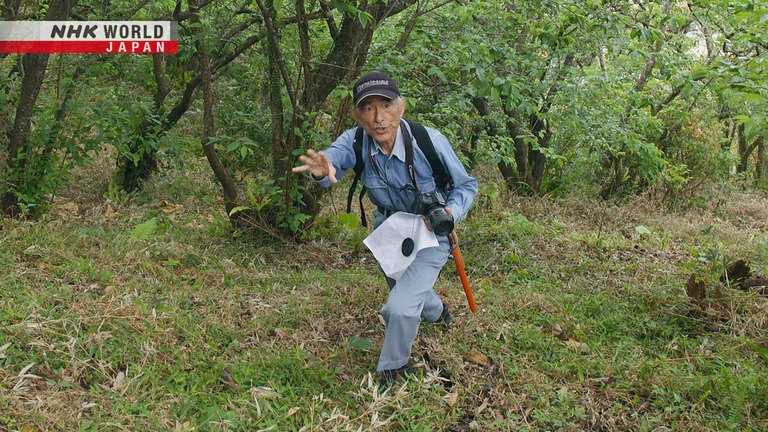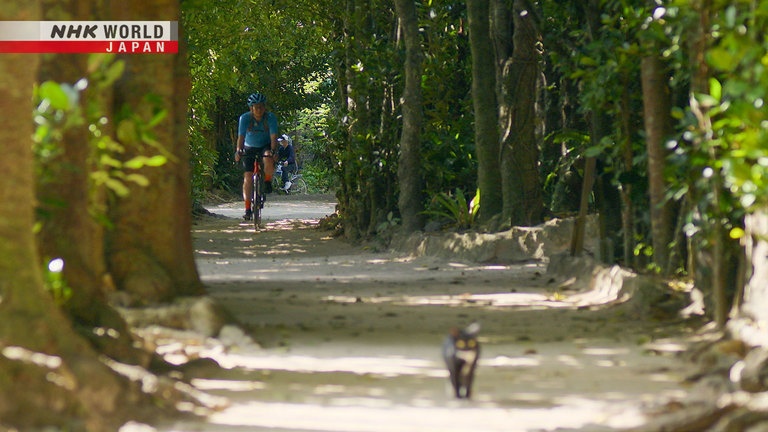Okinawa - A Unique Island Culture
The subtropical island of Okinawa Prefecture, 1,600km south of Tokyo, has an environment and climate very different to mainland Japan. The culture is different too, thanks to its history as an independent kingdom until the 17th century. We meet a folk singer whose songs commemorate the sufferings of the Okinawan people from the samurai conquest to the US invasion of WWII, and a local historian devoted to recovering the past of his community. We also discover the secret of the Okinawans' famous longevity – the island food.




Transcript
The best way to discover little-known sights and make even familiar places feel brand new,
is to go exploring by bicycle.
This time, we're on the subtropical island of Okinawa.
Okinawan culture is unique, very different to the rest of Japan.
The food is special too, on this island blessed by nature.
My life work is to spread the word
about Okinawa's wonderful food.
This is an island with a long and important history.
Someone has to record our history,
and tell it to as many people as possible.
A three-day ride through Okinawa, getting to know its friendly, resilient people.
The islands of Okinawa lie at the southernmost edge of Japan.
And we begin our trip from the southernmost point of the main island, Cape Kyan.
Right, today I'm about to start my Okinawan adventure.
Paul Imperatrice, from New Zealand, has lived in Japan for 33 years.
Originally brought here by his passion for eastern philosophy and martial arts,
Paul runs a small English school in Tokyo.
Right, all set to go.
And now I'm off.
Back in Tokyo, the early March weather is still wintry,
but down here it's a balmy 21 degrees Celsius.
Already the scenery is very different from Tokyo.
Different types of plants, sort of tropical, subtropical.
We're now on the west coast.
Lots of very, very beautiful flat water.
It's so clear you can see through it.
After 50 kilometers on the road, Paul is now getting close to Okinawa City.
I'm riding up here, sort of in between the Kadena Air Force base
which is, oh there it is, you can see it.
Kadena Air Base was built by the Japanese military during World War II.
After the war, the facility was taken over by the occupying US forces,
which have now been using it for more than 70 years.
In Okinawa City, which lies close to Kadena, it's easy to see the cultural influence of its American neighbors.
It's now evening, so Paul decides to check out the local music scene.
Fascinating.
- Hello!
- Oh! Come in!
- This is where I can hear Okinawa "minyo?"
- Yes! Okinawa songs!
- You play them here?
- We have a live performance tonight!
The club is owned by Yohen Aiko, a famous Okinawan folk singer.
"Minyo" are folk songs about the things
that happen in people's everyday lives.
After working all day in the fields,
villagers would come together in the evening.
Singing and playing shamisen was a way to
revive themselves after a hard day's toil.
In the post-war occupation years, many Okinawans turned to their traditional songs
for solace and healing from the trauma of war.
A child of the occupation years, Aiko discovered she had a talent for singing,
and in her 20s made her debut as a "minyo" singer.
50 years ago, then at the peak of her popularity,
she opened this club so she could perform for her local fans.
Tonight, she's singing some of the best loved songs from that era.
"Sweet potatoes and salt they fed us,
breakfast, lunch and dinner."
"Their love that kept us alive.
Never forget that love."
"Never forget the debt we owe our parents."
As I told Paul before, Okinawan folk songs are
all about things people experience in daily life.
In the old days, we didn't have rice to eat.
We got our nourishment from sweet potatoes.
First thing every morning, our parents
would cook a big pan of sweet potato.
We must never forget what we owe to this food.
Now in her 80s, Aiko still takes to the stage to keep alive these memories
of how Okinawans endured hard times and survived.
She wanted to share her music because she believed that music has the power to ease pain,
bring people together and heal.
So in her own way she was encouraging people to continue the Okinawan language
and enjoy Okinawan music that was able to reach all different kinds of people.
We're now in the northern part of Okinawa, and Paul is riding through the tranquil village of Bise.
These magnificent trees were planted about 300 years ago
as protection from typhoons and strong winds off the sea.
Wow, what a paradise.
Paul is now approaching the coastal village of Ogimi.
What are you doing?
Gathering ingredients for today's menu.
I run a farm-to-table restaurant.
I grow and cook everything here myself.
In your own restaurant?
- And this is where I grow all the food.
- That's wonderful.
For over 30 years, Kinjo Emiko has been using the fruits and vegetables she grows here
to create natural, healthy meals in her nearby restaurant.
It's like a little forest garden.
Yeah, a banana.
- Pick the leaves that look most tender.
- They're purple underneath.
- What plant is this?
- Handama.
What's special about it?
Rich in iron, with a very distinctive taste.
We eat it to prevent anemia.
Okinawan fruits and vegetables are known for being healthy and highly nutritious.
If you bring these to the restaurant,
I'll cook them into a meal for you.
Thank you. It's amazing,
the restaurant is just a few steps from the field.
Oh, that looks great!
She's made Paul a traditional village meal.
Ingana, a plant related to the sunflower, with tofu dressing.
And the "handama" leaves Paul just picked, with a sesame dressing.
And this was the "handama," the one with the purple leaf
and she's boiled it and it's become sort of a mixed purple color.
Very subtle, very fresh.
It's sort of like a spinach but it doesn't have any tangy taste at all.
Amazingly fresh.
Wow.
No wonder they say it's good for your health.
You can taste that it's just so fresh.
Some of Emiko's customers have been regulars here for over 30 years.
Are you all from the same village?
Yes, all three of us.
It's quite close to here.
This is Okushima Kikue. She'll be 97 this year.
97! But you look so young.
I eat mostly vegetables.
And I like to eat with friends, having a chat.
Being with friends. And dancing.
That's the secret to health.
Yes, I dance every day.
So you like Emiko's vegetable cooking?
- Oh yes, she's very good.
- She's the best!
She can make any vegetable taste great.
Emiko's first career was as a nutritionist in charge of planning school meals.
When she married and moved to this village,
she was greatly impressed to see how the old ladies grew all their own food.
This inspired her to leave her job and start a farm and restaurant here.
Growing, harvesting, cooking.
I believe food should go from farm straight to kitchen.
Old folks here aways knew this is the way to health.
Seeing their way of living inspired me
to promote it to everyone.
I hope to spend the rest of my life showing
people the benefits of eating naturally like this.
Even further north, Paul has now come to the area known as Yambaru.
Registered as a World Natural Heritage site in 2021, Yambaru is a wide expanse of subtropical forest.
It's very lusciously green, all different shades, a great variety of different plants and trees.
Just paradise.
Today I've got a meeting with, an arranged meeting with a historian of the area.
Hello!
Paul?
I'm Miyagi. Call me Tatchan.
Miyagi Tatsumasa is a local historian, an expert on the area's past, both ancient and modern.
Today, Miyagi is surveying a promising hillside area.
You can still see how they carved
the mountain to make this slope.
To make it steeper.
Look down there.
That was probably a path cut into the mountainside.
Miyagi thinks local farmers may have built a fortification here some time in the 11th century.
I only discovered this place a month ago.
So this is completely new information.
I want to let everyone in the community
know about it as quickly as I can.
While exploring this hill, Miyagi came across something else.
Ah yes, over here. This was dug around 1944.
It's an air-raid shelter built by a family living close
by to hide from the bombing.
Some of the fiercest fighting of World War II took place on Okinawa,
during the American invasion of the island.
The planes dropped their bombs everywhere,
even on this little village.
When the U.S. forces started attacking,
the villagers fled deep into these mountains.
After the Americans took Kunigami,
they were cut off from food.
For three months, they had to survive by
eating rats, grasshoppers and frogs.
And this was the rainy season, so they were
always drenched. It was very hard.
Miyagi originally worked for a steel company, which posted him to locations all over Japan.
In his 30s, he decided to leave that job and return to his village.
For over 40 years, he's been compiling this history of the area,
based on countless interviews and research into local archives.
He's always trying to teach his six grandchildren about the importance of knowing their island's history.
1, 2, 3, 4, 5, 6, 7
18, 19, 20, 21, 22, 23
Our history was being lost,
so I felt an urgent need to record things before it was too late.
The community must have records. So I take
these photos and add detailed descriptions.
For a long time now, I've felt this urgency to
record and inform as many people as possible.
To end his trip, Paul heads for the very northernmost tip of Okinawa island.
Here we go.
1.7k
Wow.
Unbelievable.
It slips off into deep blue sea.
Paul has reached his destination, and the three-day ride is over.
When I first came, the image of Okinawa of course is it's very blue and white sands.
It's a picture postcard place.
Of course, Okinawa was a famous battle in the Second World War and suffered terribly.
This time, riding my bike through it, I've really felt the energy of the place.
I was extremely expressed impressed with their honesty, simplicity
and the enjoyment of life that they have in a simple way.
Okinawa's long history of surviving hard times has bred a resilient people
who know the importance of enjoying the simple things of life.